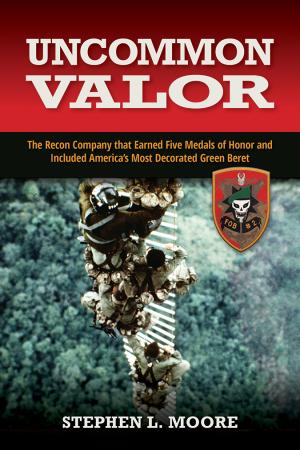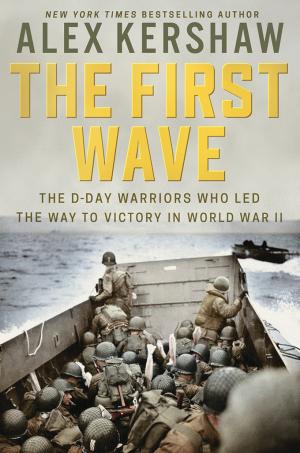June 2019 Book Reviews
June 2019 Book Reviews
Secret Unit Wreaked Havoc Behind the Lines
Uncommon Valor: The Recon Company that Earned Five Medals of Honor and Included America’s Most Decorated Green Beret.. Stephen L. Moore. Naval Institute Press. 440 pages. $35
By Lt. Col. Robert K. Brown, U.S. Army Reserve retired
No book is more aptly titled than Uncommon Valor: The Recon Company that Earned Five Medals of Honor and Included America’s Most Decorated Green Beret. This is an in-depth analysis of the American warriors who staffed the most covert and unique small-unit operations of the Vietnam War.
The reconnaissance company’s parent organization, the ubiquitous Studies and Observations Group (SOG), was mandated to conduct a variety of operations in North Vietnam, Laos and Cambodia.
Author Stephen L. Moore focuses on the day-to-day operations of one SOG reconnaissance company based at Forward Operating Base 2 in Kontum, South Vietnam, located in the Central Highlands. This particular unit was the most highly decorated unit in the war, accumulating five Medal of Honor decorations, eight Distinguished Service Crosses, and an unparalleled number of Silver Stars, Bronze Stars and Purple Hearts. It suffered 100 percent casualties. The epic descriptions of almost daily heroism truly boggle one’s mind.
Teams were overrun and in some cases totally wiped out. Yet SOG troops came back for more and more. U.S. Military Assistance Command, Vietnam-SOG, in 1969, documented that the ratio of North Vietnamese Army (NVA) soldiers killed to each Green Beret lost was 150-to-1, the highest documented kill ratio of an American unit in the war. The majority of SOG personnel were Green Berets. One, Robert Howard, was wounded 14 times, received eight Purple Hearts and was written up for the Medal of Honor after three missions. He received his Medal of Honor in 1971. SOG was not recognized by the U.S. government until 2001 when, finally, it was presented with a Presidential Unit Citation.
Operating in small teams of five to 10 men, consisting of two or three Americans and the rest either Nungs or Montagnard tribesmen, SOG operatives tapped NVA communication lines, sabotaged NVA ammunition, called in airstrikes on enemy convoys and other targets, and snatched prisoners, among other “black” operations. They went into denied areas with no identification, no unit designations, no rank, so the U.S. government could deny U.S. involvement, though that fooled no one.
In many cases, the author notes, “the SOG teams went in under enemy fire and were pursued by NVA trackers from the moment they inserted into the jungle. They remained on the ground for days or even more than a week at a time with meager rations and only the ammunition each man could carry, often engaging platoon- to division-sized enemy forces until the surviving members could be extracted by helicopter.”
Giving credit where credit is due, Moore ties in how air operations inserted teams into the fire … and pulled them out of the fire. If not for the heroics of helicopter pilots and winged aircraft, SOG would have been eliminated once the NVA formed units specifically designed to track down and kill SOG teams.
In retrospect, Moore, perhaps inadvertently, goes a long way toward proving that the warrior’s desire to fight surfaces in some due to an innate desire to engage in combat, not just because of brotherhood and attachment to fellow troopers. SOG personnel repeatedly went into high-risk situations often not knowing other team members other than to give a “hi-howdy.” And they kept going out on missions, often until wounded or killed.
Moore deserves high marks for interviewing more than 100 SOG operatives in the course of researching this book, which could easily serve as a subject for a score of movies or several TV series if we were not in a time of political correctness. It is a must-read for the serious student of unconventional warfare.
Lt. Col. Robert K. Brown, U.S. Army Reserve retired, is the founder, editor and publisher of Soldier of Fortune magazine. He served with the 1st Infantry Division and as a Special Forces political warfare officer and Special Forces A-Team leader in Vietnam. He is the author with Vann Spencer of I Am Soldier of Fortune: Dancing with Devils.
* * *
Meet the Troops Who Cracked Open Normandy
The First Wave: The D-Day Warriors Who Led the Way to Victory in World War II. Alex Kershaw. Caliber. 384 pages. $30
By Col. Kevin W. Farrell, U.S. Army retired
June 6 marks the 75th anniversary of the greatest amphibious operation in world history. Despite the passing of more than seven decades, the magnitude of the endeavor and the heroism of its participants have not faded, although this year’s anniversary will be the last major celebration with a significant number of D-Day veterans taking part.
It is therefore fitting that Alex Kershaw, an accomplished historian known for stirring personal accounts of World War II such as The Bedford Boys: One American Town’s Ultimate D-Day Sacrifice and The Longest Winter: The Battle of the Bulge and the Epic Story of World War II’s Most Decorated Platoon, should release a compelling new book highlighting the nature of this epic campaign from the perspective of those who were in “the first wave.”
Beginning with decision-making at the highest level, the reader of The First Wave experiences the tremendous strain faced by Supreme Allied Commander Gen. Dwight D. Eisenhower and his difficult decision to launch the invasion despite the horrendous weather with his famously succinct phrase, “OK. We’ll go.” Kershaw proceeds briskly through eyewitness accounts from various perspectives, specialties and nationalities.
Following the landings, Kershaw explores the brutal fighting in the bocage. An epilogue allows the reader to see what happens later in the lives of many of the combatants.
One of the more endearing figures encountered is Lord Lovat, the eccentric but fierce Scottish commander of the 1st Special Service Brigade. Lovat had the distinction of being accompanied by the only kilt-wearing bagpiper in the invasion force. Despite his unusual demeanor, Lovat brought experience, ruthlessness and courage in combat. By the end of the book, the reader learns of the interesting and tragic events that occur over the course of his life.
Kershaw puts events ranging from the humorous to the heartbreaking into context against the backdrop of an operation so large it almost defies comprehension. A case in point is Maj. John Howard, an extraordinary British infantry officer and a rarity among British officers because of his former enlisted status. Howard’s small command of 180 men conducted Operation Deadstick, the mission to seize the crucially important bridges across the Caen Canal and Orne River. These bridges provided British landing forces their only eastward egress. The first three of six Horsa gliders landed in amazingly close proximity just after midnight and the bridges enabled Howard’s hand-picked men to make Ranville and its key crossings the first French village liberated by the Allies.
With humor and poignancy, Kershaw recounts small details behind the legendary operation. For example, Howard thought he had been blinded by the hard landing of his glider, until he realized his helmet had shifted and covered his eyes. Howard also lost his close friend and lead platoon leader, Lt. “Den” Brotheridge, the first Allied soldier killed in France. Upon learning the sad news, Howard thought immediately of Brotheridge’s young widow, only days from giving birth to a baby girl.
Many impressive leaders shine throughout. Capt. Frank Lillyman, commanding officer of the pathfinders of the 101st Airborne Division, was the first American to touch ground in France. Lt. Col. James Rudder, commander of the 2nd Ranger Battalion, led the almost impossible mission to scale the cliffs at Pointe du Hoc. The chaos of Omaha Beach, forever remembered as “Bloody Omaha,” is vividly recounted through individual accounts and inspiring examples of small-unit leadership.
Divided into 13 chapters as well as an epilogue, The First Wave is fast-paced and appropriate for anyone with an interest in World War II. Although many of the episodes within it have been addressed in other histories, Kershaw brings to life the individuals who carried out the gritty work of D-Day.
Col. Kevin W. Farrell, U.S. Army retired, is the former chief of military history at the U.S. Military Academy at West Point, New York. He commanded a combined arms battalion in Iraq. His most recent book is The Military and the Monarchy: The Case and Career of the Duke of Cambridge in an Age of Reform, and he has a doctorate from Columbia University, New York.
* * *
Washington Oversaw the Birth of an American Army
The British Are Coming: The War for America, Lexington to Princeton, 1775–1777. Rick Atkinson. Henry Holt and Co. 800 pages. $40
By Col. Bryan R. Gibby
Rick Atkinson’s The British Are Coming is the origins story of the American nation and its Army. As the first of three volumes, it narrates the first two full years of the American Revolution and is punctuated by high politics, determination, bungling, diplomacy, close combat and desperate leadership.
Atkinson’s vibrant prose identifies and elaborates on critical themes to understand the political context of the Revolution and its effects on military strategy and operations. He calls the war “an improvised struggle between two peoples of a common heritage, now sundered by divergent values and conflicting visions of a world to come.” This analysis is significant, as it explains Britain’s initially halting approach to tame the Boston-centered rebellion, followed by the overwhelming application of power after tactically mismanaged battles at Bunker Hill, Massachusetts, and Sullivan’s Island, South Carolina. The two strategically insignificant engagements put to rest breezy notions that the rebellion lacked depth or broad geographic support.
George Washington was a complicated rebel and dedicated patriot who resented imperial bonds limiting American potential. Atkinson follows Washington’s maturation as a commander in chief and how his influential leadership marked the transformation of a rebellion into a revolution.
The general’s journey was not without mishap. British Gen. William Howe severely schooled the Continentals at Long Island, Manhattan and White Plains, all in New York. The loss of Fort Washington, New York, with its nearly 3,000 fighting men—not to mention 2,800 precious muskets, 41 cannon, and “heaps of salt meat, potatoes, and other provisions”—was as unnecessary as it was amateurish.
Further, the loss of Fort Washington was almost decisive. It called into question the Virginian’s supposed qualities of resolution, as demonstrated at Boston; daring, as displayed in the dispatch of Benedict Arnold’s small force to, unsuccessfully, assault Quebec; and good fortune, as experienced in the near-providential escape of his Army from Long Island. Washington’s much-reduced Army was compelled to flee, abandoning southern New York and nearly all of New Jersey. His most experienced and trusted subordinate, Maj. Gen. Charles Lee, a self-important but competent officer, was captured by British dragoons led by Banastre Tarleton. Philadelphia, the rebel capital, lay exposed.
With enlistments about to expire, Washington deliberated with his war council—one of the rare instances when a bold decision was made through committee—and launched an audacious assault on sleepy Trenton, New Jersey, the day after Christmas. The countersign was “Victory or Death,” and Washington probably meant it. Atkinson lauds his personal bravery throughout the campaign to outmaneuver Maj. Gen. Charles Cornwallis at Princeton, New Jersey, acknowledging that Washington knew the difference between a calculated risk and a gamble. Boldness won back New Jersey, preserved the Army and put polish to Washington’s tutoring in the school of the hardest knocks.
Though this is a long book, Atkinson keeps the pace moving with pithy quotations, anecdotes and insights into 18th-century warfare. “In war, as in farming, topography was fate.” Washington misread his terrain more than once during the New York campaign, and it nearly killed his Army. “Salt was almost as much a unum necessarium as gunpowder” reminds even the most brilliant tacticians of the iron tether of logistics. Both British and Continental armies were limited by what their sustainment resources could support.
Atkinson gives the war’s ideological component its proper context, from George III’s self-assured confidence in victory to the American Declaration of Independence, which Washington had read aloud to every regiment in the Army. The declaration was a clear statement of what victory looked like, and “if men were asked to die, they would know why.”
If the American Army has a muse, it is Rick Atkinson. An entire generation of soldiers has been nursed and inspired by his stories of grit, adaptation and triumph. Though a historian will never claim to foretell the future, good history does allow brief glimpses into the vague future. History is the study of what is possible, an examination of motives, and a precis of the hearts of men and women whose cumulative deeds bequeathed to us identity, purpose and idealism. Atkinson reminds us that our heritage of service has deep roots in the soil of America’s past.
Col. Bryan R. Gibby is chief of military history at the U.S. Military Academy at West Point, New York. He is the author of The Will to Win: American Military Advisors in Korea, 1946–1953 and other publications dealing with the Korean War.
* * *
Looking Back on an Important General’s Career
Maxwell Taylor’s Cold War: From Berlin to Vietnam. Ingo Trauschweizer. University Press of Kentucky (An AUSA Title). 328 pages. $45
By Lt. Col. James Jay Carafano, U.S. Army retired
Maybe the problem is that, when we were soldiers once and young, we read too much Once an Eagle and not enough history. For many young officers, the novel by Anton Myrer was an object lesson about what dragged us into a disastrous war in Vietnam. Once an Eagle contrasted the selfless servant, Sam Damon, with Courtney Massengale, the self-serving career-climber who outfoxed him in the end. Many suspected the model for Massengale was Maxwell Taylor.
In Maxwell Taylor’s Cold War: From Berlin to Vietnam, Ingo Trauschweizer delivers a balanced, scholarly and sober perspective that offers both a more nuanced view of that significant military figure and an important case of leadership in an uncertain political-military age. Trauschweizer is an associate professor at Ohio University. His new book is not only well-done, but also well-focused.
Commissioned in 1922, Taylor had a long career of military and public service. Maxwell Taylor’s Cold War centers on the period of the general’s life from his post-war assignments through his time as ambassador in Saigon. That’s useful for those following contemporary military affairs. In the early Cold War, the U.S. struggled with adapting its strategy and armed forces to the new operating environment. Similarly, Americans today grapple with adapting to the dramatic strategic changes since the end of the Cold War.
One topic of particular interest is Taylor’s role in developing limited war theory and strategy. Once the U.S. and Soviet Union both fielded powerful nuclear arsenals, scholars began to speculate that rather than resulting in a standoff, the two sides would look for other ways to harry each other. Taylor was a major player in the debate. As early as 1948, he warned, “Our planners will have to make provisions for meeting an enemy who comes in strange and unconventional forms.” It is worth reading Trauschweizer’s treatment of how Taylor contended with issues that will remind of contemporary arguing over how to respond to hybrid warfare.
Also worthy of attention is Taylor’s turn as Army chief of staff. He faced declining forces and resources, increasingly anemic budgets and readiness deficits. His solution was the “Pentomic Army,” dual-capable forces that could fight in conventional or nuclear combat. His reforms largely fell flat.
Another episode in Taylor’s career that will resonate is the challenge of dealing with protracted wars. In his 1997 book, Dereliction of Duty, H.R. McMaster offered a devastating criticism of Taylor, arguing he misrepresented the views of the Joint Chiefs of Staff to the secretary of defense. Trauschweizer concludes that Taylor understood the complexity of the war in Vietnam, but in the end his advice was “self-defeating.”
What emerges in Maxwell Taylor’s Cold War is the story of a dedicated soldier and public servant, a brilliant thinker, but a complex and flawed person who made compromises that undermined some of the good he tried to do. Unquestionably, Taylor is an important figure in American military history who deserves our attention. Further, understanding the problems he faced could inspire us to think more deeply about the problems we face.
Lt. Col. James Jay Carafano, U.S. Army retired, is vice president of the Kathryn and Shelby Cullom Davis Institute for National Security and Foreign Policy and the E.W. Richardson Fellow at the Heritage Foundation think tank, Washington, D.C. He has a doctorate from Georgetown University, Washington.





